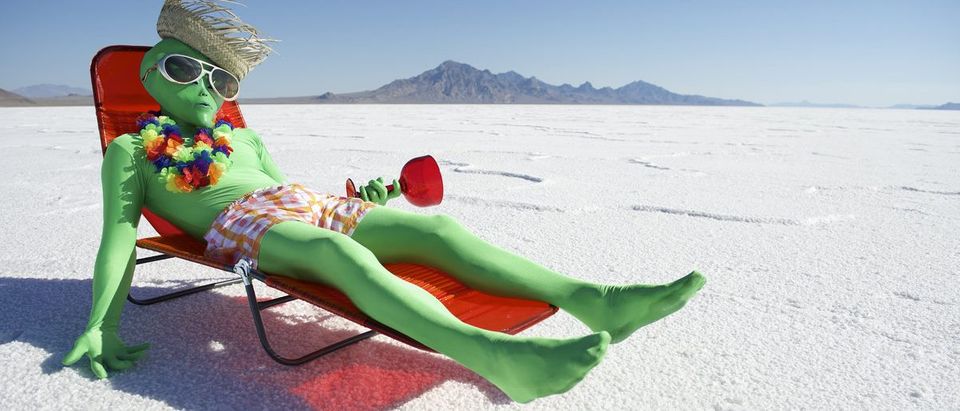Life on “Proxima b” would be way different than on Earth because of the extreme conditions on the so-called “second Earth,” say scientists who study how life might form on other worlds.
“Proxima b is exciting because it is very close to us and is right in the middle of its star’s habitable zone,” Dr. Daniel Apai, an astrobiolist at the University of Arizona, told The Daily Caller News Foundation, adding the newly-discovered world is “probably one of our best targets to explore for signatures of life.”
Astronomers gleefully announced the discovery of a potential “second Earth” Wednesday after finding a slight “wobble” of gravity tugging on the star Proxima Centauri. This indirect method of detection means scientists don’t currently know if the planet, called “Proxima b,” has an atmosphere or possesses a magnetosphere, but there’s already a lot speculation about the possibility of life on the planet.
“The planet was indirectly detected and so there’s a limited amount we know about the planet,” he said. “Nobody has actually seen it yet, but it is probably only slightly larger than Earth.”
Since Proxima Centauri is 7 times smaller than the sun, the planet is likely in the “Goldilocks Zone,” the region around a star that has just the right conditions to find liquid water on a planet’s surface.
“Some organisms from Earth may actually be able to conduct photosynthesis on Proxima b,” Dr. Apai speculated. “Any organisms that could exist there would have to find a way to protect themselves from the star. Perhaps they live below the surface of the planet or an ocean. That could be a potential way organisms could defend themselves from the star.”
Proxima b is likely tidally locked around its star, meaning one side of the planet constantly faces the star, while the other side is always dark. This greatly influences the potential for life and even gives scientists hints about what life there may look like.
“The potential tidal locking of the planet might not be a showstopper,” Dr. Penelope Boston, director of NASA’s Astrobiology Institute, told The Daily Caller News Foundation. “On the day side, some sort of photosynthesis might be possible, although with a different solar spectrum than our Sun, it is unlikely that the main photosynthetic pigment would be green like chlorophyll. So plants on such a world would be a different color, perhaps blue, perhaps red, perhaps even black.”
Though Proxima b’s year only lasts 11.2 days, it probably has an average surface temperature of around minus 40 degrees Fahrenheit, which is enough toallow liquid water to exist in places on the planet.
“If the planet’s composition is similar enough to Earth it could potentially have ice caps, oceans and water vapor,” Dr. Apai continued. “There are telescopes that are being designed and could be built in 10 years which could be capable of mapping the planet and determining if the planet has an atmosphere and studying it.”
Proxima b’s biggest drawback for life is that “the high likelihood of very strong solar flares on this type of star means that the planet would experience repeated episodes of strong ionizing radiation,” Dr. Boston told TheDCNF. “On the up side of the balance sheet, such small dim stars tend to live for a very long time, thus, if they actually do have planets that bear life, those biospheres could persist for an extremely long time, far longer than our biosphere has lasted or is likely to last because of the potential lifespan of our Sun.”
If microbial life did develop on Proxima b, the harsh conditions may have permanently locked it into a relatively primitive form.
“Evolution isn’t compelling organisms to be complex. Whatever works best is what flourishes,” Dr. Apai told TheDCNF. “It is quite possible that life could remain much more primitive for extended periods and that habitable planets could generally develop life.”
For the vast majority of its history, life on Earth was relatively primitive. The earliest potential evidence of life on Earth is 3.5 billion years old, but the first multi-cellular animals did not appear until about 600 million years ago and were not diversified until roughly 542 million years ago in the Cambrian “explosion.”
“The most likely lifeform to arise on any planet is microbial is scale,” Dr. Boston noted. “We know that 3/4 of the history of life on this planet was microbial before larger organisms arose. While individually tiny, such organisms on Earth tend to grow in large communities in many environments and their presence can be easily detected by the naked eye in some cases.”
Although Proximba b is by far the closest potentially habitable exoplanet to our solar system, but it would still take more than 1,000 years to arrive using today best rocketry developed, according to Universe Today. If there were technologically advanced aliens living on Proxima b, it would take 4.6 years for any radio signals sent from Earth to reach them.
“If we go to a star in the near future, Proxima Cenaturi is the one we’d target, but going there would still require an insane amount of energy,” Dr. Apai told TheDCNF. “The next step is to study this planet by remote sensing, in the next 20 years we’ll probably have a pretty good idea of the planet’s atmosphere. We may be able to send a small probe within a few decades.”
Send tips to andrew@
All content created by the Daily Caller News Foundation, an independent and nonpartisan newswire service, is available without charge to any legitimate news publisher that can provide a large audience. All republished articles must include our logo, our reporter’s byline and their DCNF affiliation. For any questions about our guidelines or partnering with us, please contact licensing@dailycallernewsfoundation.org.


